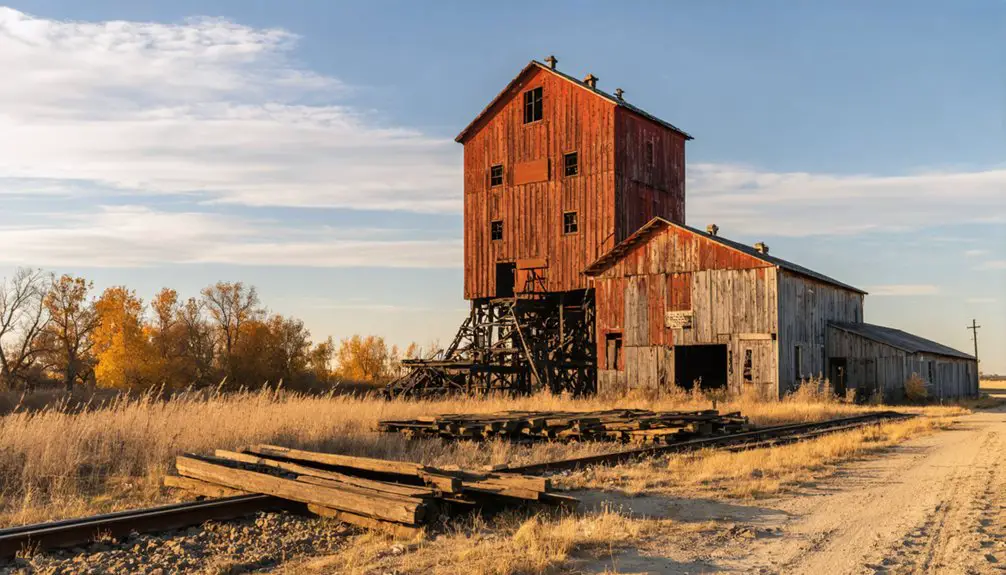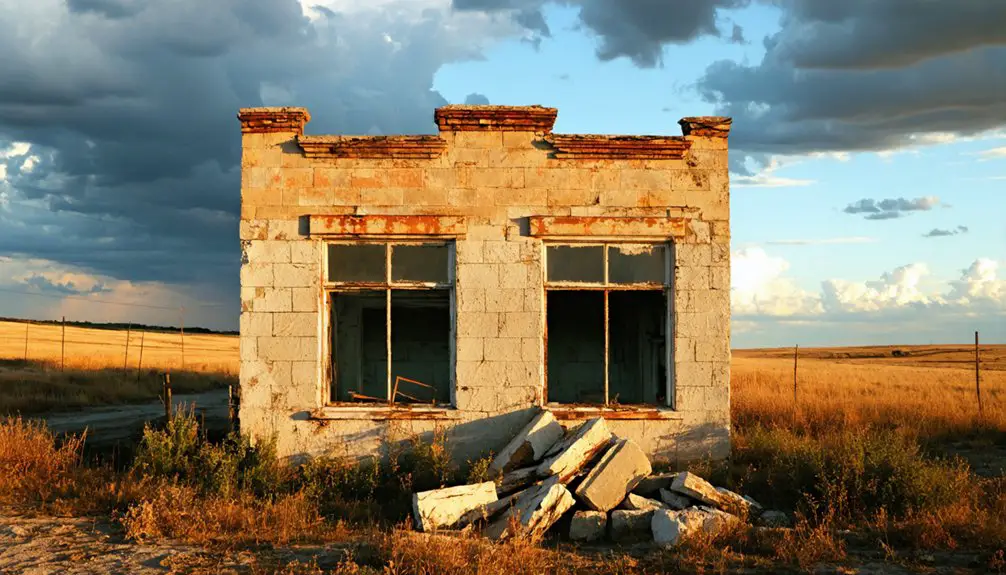You’ll find Sherlock’s ghost town story in Finney County, Kansas, where railroad officials established it in 1872. Named after director Thomas Sherlock Sr., the town flourished briefly with essential businesses, including Spencer and Company’s store and the popular “Hoo Doo Shop” saloon. By 1905, Garden City’s sugar factory deal lured residents away with free relocation offers, leading to Sherlock’s decline. The town’s transformation into present-day Holcomb reveals an intriguing tale of frontier resilience.
Key Takeaways
- Sherlock was established in 1872 by railroad officials and named after director Thomas Sherlock Sr., becoming a strategic point between Dodge City and Pierceville.
- The town initially thrived with businesses like Spencer and Company’s retail store and the popular “Hoo Doo Shop” saloon serving railroad workers.
- Garden City’s 1905 sugar factory deal led to mass exodus from Sherlock, with residents accepting free relocation offers and moving entire buildings.
- The post office closure in 1880 marked significant decline, though the town briefly revived and reopened its post office in 1883.
- The town transformed into present-day Holcomb around 1910, named after D.C. Holcomb, marking the end of Sherlock’s original identity.
The Birth of a Railroad Town
While the westward expansion of America was transforming the frontier in 1872, officials from the Atchison, Topeka & Santa Fe Railroad established the town of Sherlock in what was then Sequoyah County, Kansas.
Named after railroad director Thomas Sherlock, Sr., the town’s location was strategically chosen to optimize railroad logistics between Dodge City and Pierceville.
Railroad director Thomas Sherlock Sr. lent his name to a strategic rail hub connecting Dodge City and Pierceville.
You’ll find that Sherlock emerged as part of a calculated town planning initiative along the Arkansas River, following the historic Santa Fe Trail.
Though founded in 1872, the town wasn’t officially platted until 1882.
By 1879, you could’ve found essential services like a store, lumber yard, restaurant, and saloon.
Similar to how Beaumont citizens raised money for their railroad, local residents contributed relief funding to support railroad operations.
The military even stationed soldiers there in 1874 to protect the railway from Indian attacks, ensuring the crucial rail link remained secure.
The town underwent a significant change when it was renamed to Holcomb in 1910.
Early Business and Commerce
As Sherlock took shape in the late 1870s, you’d have found a bustling commercial district anchored by Spencer and Company’s retail store and J.E. Woods’ lumber yard.
These early commercial establishments formed the foundation of Sherlock’s local economy, serving both townspeople and ranching operations in the area. Like many frontier towns, Sherlock’s log store was among its first buildings, providing essential supplies to settlers.
- Thomas Julian’s restaurant and bakery, alongside J.H. Holmes’ boarding house, provided essential services to hungry cowboys and travelers.
- The “Hoo Doo Shop” saloon became a social hub by July 1879.
- Fred Harvey’s acquisition of the Porter horse ranch in 1881 brought notable investment to the area.
- Major Falls’ cattle operations and the XY Ranch’s frequent business helped sustain the town’s merchants.
Sherlock’s strategic location made it a natural hub for commerce, though competition from Garden City would later challenge its prosperity. The town’s identity changed significantly when it was renamed to Holcomb in 1909.
Life in Early Sherlock

Though Sherlock’s official founding occurred in 1872, life didn’t truly begin in the town until 1879 when the first wave of settlers arrived to claim their parcels of government land.
Like many Kansas settlers, these early residents struggled to establish successful corn farming operations due to limited rainfall in the region.
You’d find the early residents adapting quickly to frontier life, with some living in dugouts while constructing more permanent homes from lumber shipped in by rail.
Daily routines centered around cattle ranching and fishing, with locals keeping barrels of fresh fish in the river for their tables.
Community gatherings often took place at the section boarding house, known for its welcoming atmosphere and hearty meals.
Similar to settlers along the Chisholm Trail, residents would often trade goods and services with passing cattle drivers who stopped to rest at nearby water sources.
The Garden City Deal
You’d notice stark changes in Sherlock’s fortunes when Garden City’s 1905 sugar factory deal sparked intense competition between the neighboring towns for residents and workers.
Garden City’s aggressive incentives, including promises of reliable water access and stable employment at the new factory, proved too appealing for many of Sherlock’s families to resist. When local townspeople raised a $30,000 bonus to secure the sugar factory deal, it further cemented Garden City’s position as the region’s economic powerhouse. As a place name disambiguation, Garden City refers to multiple locations throughout Kansas and beyond.
The mass departure of residents to Garden City left Sherlock struggling to maintain its community, as both established families and newcomers chose the economic prospects of the larger, more industrialized neighbor.
Relocation Incentives Attract Residents
Several compelling incentives draw new residents to Kansas’s rural regions, with programs like Choose Topeka offering up to $10,000 for home buyers and $5,000 for renters within their first year.
You’ll discover abundant financial benefits across the state’s 95 Rural Opportunity Zones, designed to revitalize less populated areas. The average rent in Topeka sits at $995 per month, making it an affordable choice for newcomers.
- Income tax waivers and student loan repayment assistance make rural Kansas an attractive option for professionals seeking financial freedom.
- Remote workers can access housing support, including down payment assistance and rent subsidies. The Choose Topeka program allows remote workers to maintain connections to major cities while enjoying the benefits of smaller community living.
- Community engagement opportunities come bundled with cultural perks, event tickets, and networking resources.
- Programs often combine monetary incentives with lifestyle benefits, helping you establish roots in welcoming communities while maintaining professional flexibility.
These strategic incentives aim to breathe new life into Kansas’s rural landscapes, offering you a chance at both economic opportunity and small-town charm.
Competition Between Towns Intensifies
While relocation incentives attract newcomers to Kansas’s rural areas, towns like Garden City actively compete to retain both residents and businesses through innovative local programs.
You’ll find town rivalries intensifying as communities battle for economic survival, with initiatives like the Best of Garden City Contest spurring healthy competition among local enterprises.
CherryRoad Media’s Garden City Telegram plays a crucial role in this competitive landscape, highlighting successful businesses like Freedom Electric Inc. through community journalism.
You’re witnessing how these recognition programs don’t just boost local pride – they’re strategic tools for economic growth. When you support recognized businesses, you’re helping create jobs and strengthen infrastructure.
Towns that invest in these competitive programs often see increased consumer loyalty and enhanced regional reputation, giving them an edge in the ongoing challenge of small-town sustainability.
Mass Exodus From Sherlock
During a challenging period of harsh environmental conditions, Garden City made a strategic move that would seal Sherlock’s fate – offering its residents free relocation, including the moving of entire buildings.
The mass migration that followed marked the beginning of Sherlock’s community decline. You can trace the town’s dramatic transformation through these key events:
- Most citizens accepted Garden City’s generous offer, packing up their lives and businesses.
- The post office closed on August 19, 1880, signaling the town’s diminishing importance.
- Only cowboys and a handful of determined settlers remained behind.
- The harsh environment, with its hot, dry, and windy conditions, further discouraged new settlement.
The once-promising town had transformed into a near ghost town, its streets eerily quiet where bustling activity once prevailed.
From Sherlock to Holcomb
As Sherlock’s population dwindled in the late 1800s, the town began a remarkable transformation that would ultimately lead to its rebirth as Holcomb.
After the town’s initial decline and post office closure in 1880, resilient settlers started rebuilding, establishing new businesses along the Atchison, Topeka & Santa Fe Railroad line.
You’ll find the town’s historical significance marked by its post office reopening in December 1883.
The most dramatic change came when the town name shifted to Holcomb around 1910, honoring D.C. Holcomb, a key figure in developing the area.
This transformation wasn’t just about a new name – it represented a fresh start for a community that refused to become another forgotten Kansas ghost town.
Today, the thriving community of Holcomb stands as proof of the pioneering spirit that kept this settlement alive.
Legacy on the Kansas Plains

Since its founding in 1872, Sherlock’s legacy on the Kansas plains tells a story common to many frontier settlements.
You’ll find its cultural significance woven into the broader tapestry of Kansas history, where environmental challenges shaped the destinies of countless towns.
- The town’s rise and fall mirrors the experience of many railroad-founded communities that struggled against harsh climate, drought, and competition.
- Your glimpse into frontier life emerges through the town’s early establishments – saloons, boarding houses, and land agencies that once bustled with activity.
- The transformation from Sherlock to Holcomb demonstrates the resilience of plains communities adapting to survive.
- Its ghost town status serves as a reflection of the dramatic impact transportation routes and economic shifts had on early Kansas settlements.
Frequently Asked Questions
What Was the Population of Sherlock at Its Peak?
You’ll find historical records don’t provide an exact peak population, but evidence suggests Sherlock reached between 600 to 1,000 residents during its prime mining years in the early 1900s.
Are There Any Remaining Buildings or Structures From the Original Town?
Time has taken its toll – you won’t find any standing buildings today. The ghostly remnants of Sherlock’s architectural history are limited to scattered foundations and possible ruins beneath the prairie.
Did Any Notable Historical Figures Ever Visit Sherlock?
You won’t find records of any famous visitors stopping by this settlement. While early pioneers like A.F. Lee settled there, the town’s brief existence and limited historical significance didn’t attract notable figures.
What Was the Average Land Price in Sherlock During Its Existence?
You won’t find specific land price records, but based on regional land value trends and real estate fluctuations of the era, prices likely followed Kansas’s typical rural patterns during 1872-1890.
How Far Was Sherlock From Other Major Kansas Towns of That Era?
Like a hub in a wagon wheel, you’d find Sherlock nestled between major transportation routes, about 35-40 miles from Dodge City and 12 miles from Garden City’s geographical significance.
References
- https://legendsofkansas.com/holcomb-kansas/
- https://fhsuguides.fhsu.edu/kansasheritage/finneycounty
- https://www.youtube.com/watch?v=OyBXD18P_j4
- https://www.youtube.com/watch?v=alC1wDdSVvg
- https://en.wikipedia.org/wiki/List_of_ghost_towns_in_Kansas
- https://www.meridianspeedway.net/kcpg-centennial-history.html
- https://www.kspatriot.org/index.php/articles/34-kansas-commerce/557-the-railroads-that-developed-southwestern-kansas.html
- https://kearnycountymuseum.org/1222-2/
- https://dianastaresinicdeane.wordpress.com/2012/01/29/columbia-a-kansas-ghost-town-story/
- https://www.hhhistory.com/2019/05/ghost-towns-of-kansas.html



